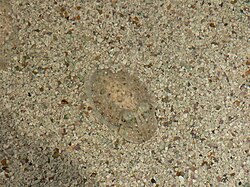Changing colorCuttlefish are sometimes called the chameleon of the sea because of their remarkable ability to rapidly alter their skin color at will. Their skin flashes a fast-changing pattern as communication to other cuttlefish and to camouflage them from predators. This color-changing function is produced by groups of red, yellow, brown, and black pigmented chromatophores above a layer of reflective iridophores and leucophores, with up to 200 of these specialized pigment cells per square millimeter. The pigmented chromatophores have a sac of pigment and a large membrane that is folded when retracted. There are 6-20 small muscle cells on the sides which can contract to squash the elastic sac into a disc against the skin. Yellow chromatophores (xanthophores) are closest to the surface of the skin, red and orange are below (erythrophores), and brown or black are just above the iridophore layer (melanophores). The iridophores reflect blue and green light. Iridophores are plates of chitin or protein, which can reflect the environment around a cuttlefish. They are responsible for the metallic blues, greens, golds, and silvers often seen on cuttlefish. All of these cells can be used in combinations. For example, orange is produced by red and yellow chromatophores, while purple can be created by a red chromatophore and an iridophore. The cuttlefish can also use an iridophore and a yellow chromatophore to produce a brighter green. As well as being able to influence the color of the light that reflects off their skin, cuttlefish can also affect the light's polarization, which can be used to signal to other marine animals, many of which can also sense polarization.
Tuesday, August 12, 2008
Cuttlefish - Wikipedia, the free encyclopedia
Blogged with the Flock Browser
Subscribe to:
Post Comments (Atom)



No comments:
Post a Comment